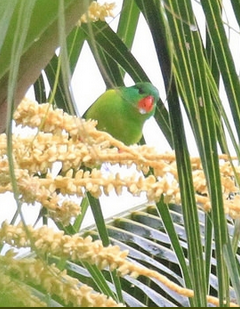Red-chinned Lorikeet |
|
|
Also known as: Red-chinned Lory
Photos
View in GalleryDid You Know?
The Red-chinned Lorikeet is quite tame in the wild; they are quite approachable while feeding.Academic Research
Related publications: Charmosyna rubrigularisSpecies Profile
Genus: Charmosyna | Species: rubrigularis
Size:
17cm (6.6 in)
Weight:
33-40g (1.2-1.4 oz)
Subspecies including nominate:
one
Colour Adult:
Both adults mostly green in colour; red chin and base of lower mandible, not reaching to lores; underwing band bright yellow; green tail tipped with yellow, with red at lateral feather bases. Bill orange/red. Eye orange.
Colour Juvenile:
As in adults but with little or no red on chin.
Call:
Call described as soft and repetitious; emitted while in flight or occasionally while feeding. Also some harsh notes.
Listen NowMore Information:
Content Sources:
CITES
BirdLife International
Cornell Lab of Ornithology/Birds of the World
A Guide to Parrots of the World, Juniper and Parr, 1998
xeno-canto Red-chinned Lorikeet, Lambert, Frank, XC24645
Parrots of the World, Forshaw, 2006. 2010 edition
Lexicon of Parrots, Thomas Arndt.
Photos
View in GalleryDid You Know?
The Red-chinned Lorikeet is quite tame in the wild; they are quite approachable while feeding.Academic Research
Related publications: Charmosyna rubrigularisSpecies Care
Captive Status:
Not found in captivity.
Longevity:
Not recorded.
Housing:
Not recorded.
Diet:
Not recorded.
Enrichment:
Not recorded.
Nest Box Size:
Not recorded.
Clutch Size:
Not recorded.
Incubation Time:
Not recorded.
Fledging Age:
Not recorded.
Hatch Weight:
Not recorded.
Peak Weight:
Not recorded.
Weaning Weight:
Not recorded.
Photos
View in GalleryDid You Know?
The Red-chinned Lorikeet is quite tame in the wild; they are quite approachable while feeding.Academic Research
Related publications: Charmosyna rubrigularisSpecies Wild Status
World Population:
Unknown, stable.
IUCN Red List Status:
Least Concern
CITES Listing:
Appendix II
Threat Summary:
A BirdLife “restricted-range” species. Common to abundant; population appears stable.
Range:
Bismarck Archipelago, and Karkar Island, E Papua New Guinea.
Habitat:
Found from 450-1300m (1476-4264 ft) in humid forest, primarily in mountains.
Wild Diet:
Feeds on pollen and nectar from native palms.
Ecology and Behaviour:
Are somewhat approachable in wild. May be seen together with other species of nectar feeders. Usually seen in small flocks of up to 10 birds feeding or flying overhead.
Clutch and Egg Size:
Not recorded.
Breeding Season:
Not recorded.
Photos
View in GalleryDid You Know?
The Red-chinned Lorikeet is quite tame in the wild; they are quite approachable while feeding.Academic Research
Related publications: Charmosyna rubrigularisMembers Only Resources
Please log-in now to find more research, resources and tools.
Not a Member?
Find more great information:
Gain exclusive access to 600+ pages of additional research, seminars and podcasts, specialists to ask your toughest questions, and dozens of other fun resources - when you become a WPT member.
Join Today >>

































